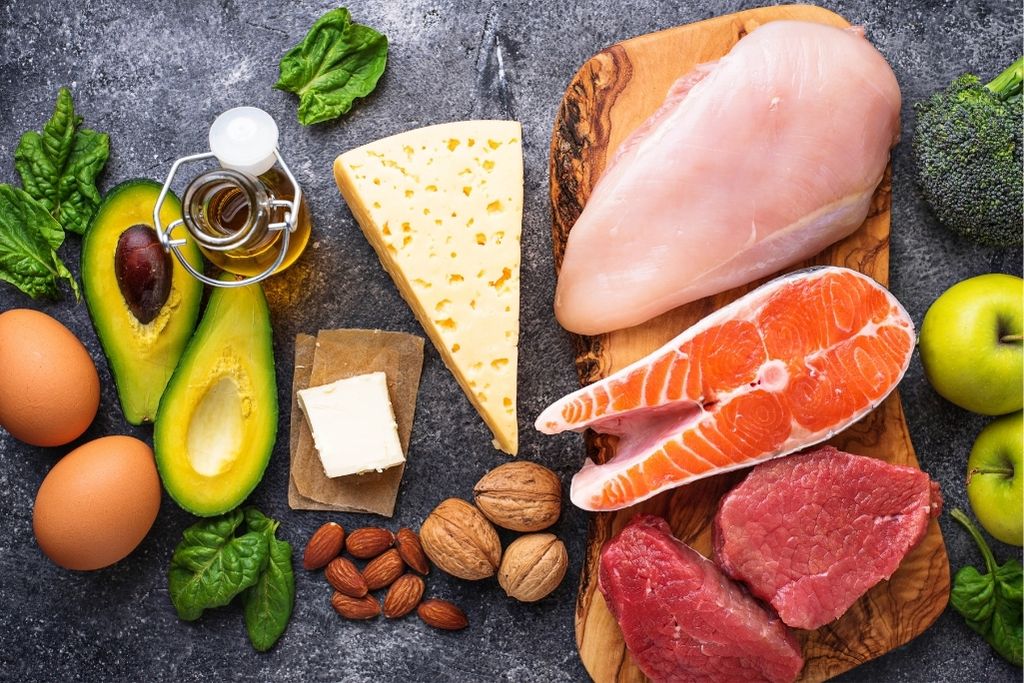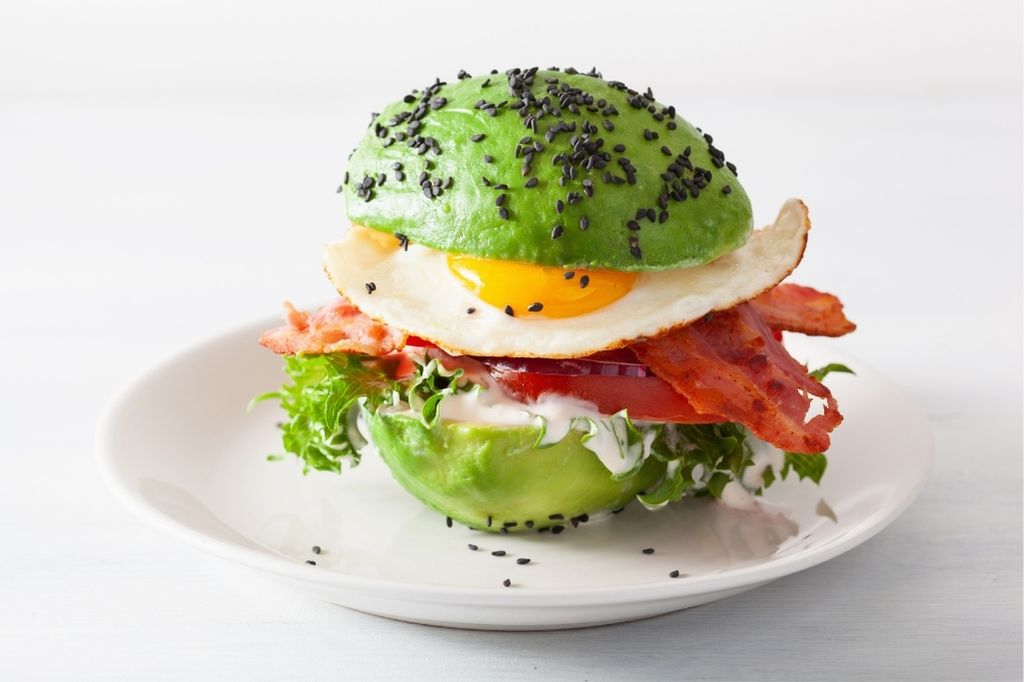
Four Popular Diets Explored
- THE KETOGENIC DIET
- THE ATKINS DIET
- THE PALEO DIET
- THE MEDITERRANEAN DIET
The Ketogenic Diet (KD)
The ketogenic diet (KD) came in use in the 1920s as a treatment for epilepsy in children, and it prescribed 1 gram of protein per kilogram of body weight, as well as limiting carbohydrates to 10-15 grams per day. The remainder of the calories were made up by fat (Wheless, 2008). The classic ketogenic diet is still used today for the treatment of epilepsy, but less restrictive versions of the diet (carbohydrates are allowed up to 50 grams per day) are being successfully researched for the treatment of several metabolic conditions.
Research shows that this type of ketogenic diet has a positive impact on a range of diseases including polycystic ovarian syndrome, type-2 diabetes, brain injury, Parkinson’s disease, Alzheimer’s disease, and dementia (Paoli et al., 2013). The KD is also utilized as adjuvant therapy in the treatment of several types of cancers (Klement, 2017). As far as weight loss is concerned, many studies show that the ketogenic diet effectively reduces weight and improves cardiovascular risk markers (Paoli, 2014). In a study on obese patients, all 83 subjects had a significant decrease in weight, BMI, total cholesterol, triglycerides, and glucose levels after 24 weeks of treatment (Dashti, 2006).
The Atkins Diet

The Atkins diet was introduced by Dr. Atkins in the 1970s and quickly became very popular. This diet is similar to the ketogenic diet as it prescribes low-carbohydrate, moderate-protein. The main difference is that the Atkins diet is divided into four phases. The induction phase is followed for at least two weeks, and it restricts carbohydrates to 20 grams per day. The balancing phase is still low in carbohydrates but allows the dieter to consume up to 50 grams of carbohydrates per day. This phase is followed until the person is 10 pounds shy of his goal weight. During the third phase, pre-maintenance, the dieter slowly increases carbohydrate intake to up to 80 grams per day, as long as weight loss does not stall. The dieter then stays at this phase for at least one month after achieving the goal weight before switching to the maintenance phase. The maintenance phase allows up to 100 grams of carbohydrates per day (Atkins Diet: What’s behind the Claims?, 2020).
The Paleo Diet
The Paleo diet refers to the diet our ancestors consumed until about 10,000 years ago, before the development of agriculture and the domestication of animals. During that time, humans ate what they could hunt and gather. The diet was made of animal flesh, naturally grown fruits and vegetables, nuts, seeds, eggs, honey, mushrooms, and tubers.
These foods are what make up the modern Paleo diet. The foods that are not allowed in this way of eating include refined sugars and artificial sweeteners, grains, corn, legumes, processed oils, dairy products, and processed foods. There is a lot of research supporting the use of the Paleo diet and showing that this diet is helpful for weight loss. It reduces total cholesterol and LDL and improves insulin sensitivity and glucose tolerance; it also lowers blood pressure (Olivieri, 2019) (Mårtensson et al., 2021).

The Meditarranean Diet
Last but not least, there is the Mediterranean diet. Studies show that the Mediterranean diet can be beneficial for weight loss (Estruch & Ros, 2020), cancer (Mentella et al., 2019), cardiovascular disease, diabetes (Tricò et al., 2021), Parkinson’s disease, and Alzheimer’s disease (Sofi et al., 2008). Traditionally, there are several different Mediterranean diets that vary based on geographical location, regional traditions, and seasonal availability. The coastal regions have a diet higher in fish, while goat, sheep, and dairy products are more predominant in the mountains.
The French enjoy duck confit and liver pate, while the Greek feast on chickpeas, lamb, and stuffed grape leaves. I grew up in Italy, and, as a child, I had liver once a week and fish once a week. Apart from the cited regional differences, the Mediterranean diets all make sure of unprocessed, nutrient-dense foods like meat and seafood, whole grains, fruits and vegetables, pulses. The main oil used is extra virgin olive oil (Gunnars, 2021).

Comparison Of All Four Popular Diets: Benefits and Deficitiancies
When we compare these four diets, we see that they have in common avoidance of refined sugars and processed foods. While the original Atkins diet didn’t focus on nutrient density, the diet has evolved to promote the consumption of whole foods. Despite this, the Atkins brand makes over $800 million a year from the sale of their processed diet food line (Doering & Doering, 2019).
In my clinical practice, I use all four of these diets for weight loss. I also use high protein diets and macro-based diets. The choice of diet is not arbitrary and must take into consideration the client’s health (hormonal imbalances, gut dysfunction, nutrient deficiencies, etc.), his food preferences, as well as his culinary skills. Most importantly, the best dietary approach is the one that is sustainable in the long term. Working on lifestyle habits is also important: many factors contribute to weight imbalances, therefore, a good weight loss program will provide education on movement, natural light, sleep hygiene, and stress management. Addressing the factors mentioned above will not yield satisfactory weight loss if we do not create a calorie deficit.
Lastly, we need to take into consideration that as the client loses weight, energy requirements will be lower. The diet must be adjusted to meet the demands of a lower basal metabolic rate (BMR). It is also important to give clients diet breaks to avoid diet burnout, boost metabolic rate and thyroid function. For these reasons, when working with individuals that need to lose more than 20 pounds, I have them eat at a deficit for no more than 12 weeks at a time, and I have the “cutting” or weight loss phase followed by a few weeks at maintenance calories before starting a new cut (Renaissance Periodization | The Importance of Maintenance, 2016).
References
Atkins Diet: What’s behind the claims? (2020, May 6). Mayo Clinic. https://www.mayoclinic.org/healthy-lifestyle/weight-loss/in-depth/atkins-diet/art-20048485
Dashti, H. M., Al-Zaid, N. S., Mathew, T. C., Al-Mousawi, M., Talib, H., Asfar, S. K., & Behbahani, A. I. (2006). Long Term Effects of Ketogenic Diet in Obese Subjects with High Cholesterol Level. Molecular and Cellular Biochemistry, 286(1–2), 1–9. https://doi.org/10.1007/s11010-005-9001-x
Doering, C., & Doering, C. (2019, August 22). Atkins owner to acquire protein-food maker Quest for $1B. Food Dive. https://www.fooddive.com/news/atkins-owner-to-acquire-protein-food-maker-quest-for-1b/561433/
Estruch, R., & Ros, E. (2020). The role of the Mediterranean diet on weight loss and obesity-related diseases. Reviews in endocrine & metabolic disorders, 21(3), 315–327. https://doi.org/10.1007/s11154-020-09579-0
Gunnars, K. B. (2021, October 25). Mediterranean Diet 101: A Meal Plan and Beginner’s Guide. Healthline. https://www.healthline.com/nutrition/mediterranean-diet-meal-plan#benefits
Klement, R. J. (2017). Beneficial effects of ketogenic diets for cancer patients: a realist review with focus on evidence and confirmation. Medical Oncology, 34(8). https://doi.org/10.1007/s12032-017-0991-5
Mentella, M. C., Scaldaferri, F., Ricci, C., Gasbarrini, A., & Miggiano, G. (2019). Cancer and Mediterranean Diet: A Review. Nutrients, 11(9), 2059. https://doi.org/10.3390/nu11092059
Mårtensson, A., Stomby, A., Tellström, A., Ryberg, M., Waling, M., & Otten, J. (2021). Using a Paleo Ratio to Assess Adherence to Paleolithic Dietary Recommendations in a Randomized Controlled Trial of Individuals with Type 2 Diabetes. Nutrients, 13(3), 969. https://doi.org/10.3390/nu13030969
Olivieri C. (2019). Combating insulin resistance with the paleo diet. The Nurse practitioner, 44(2), 49–55. https://doi.org/10.1097/01.NPR.0000552683.55684.f8
Paoli A. Ketogenic diet for obesity: friend or foe? Int J Environ Res Public Health. 2014 Feb 19;11(2):2092–107.
Paoli, A., Rubini, A., Volek, J. S., & Grimaldi, K. A. (2013). Beyond weight loss: a review of the therapeutic uses of very-low-carbohydrate (ketogenic) diets. European Journal of Clinical Nutrition, 67(8), 789–796. https://doi.org/10.1038/ejcn.2013.116
Renaissance Periodization | The Importance of Maintenance. (2016). Renaissance Periodization. https://renaissanceperiodization.com/the-importance-of-maintenance/
Sofi, F., Cesari, F., Abbate, R., Gensini, G. F., & Casini, A. (2008). Adherence to Mediterranean diet and health status: meta-analysis. BMJ (Clinical research ed.), 337, a1344. https://doi.org/10.1136/bmj.a1344
Tricò, D., Moriconi, D., Berta, R., Baldi, S., Quinones-Galvan, A., Guiducci, L., Taddei, S., Mari, A., & Nannipieri, M. (2021). Effects of Low-Carbohydrate versus Mediterranean Diets on Weight Loss, Glucose Metabolism, Insulin Kinetics and β-Cell Function in Morbidly Obese Individuals. Nutrients, 13(4), 1345. https://doi.org/10.3390/nu13041345
Wheless, J. W. (2008). History of the ketogenic diet. Epilepsia, 49, 3–5. https://doi.org/10.1111/j.1528-1167.2008.01821.x
